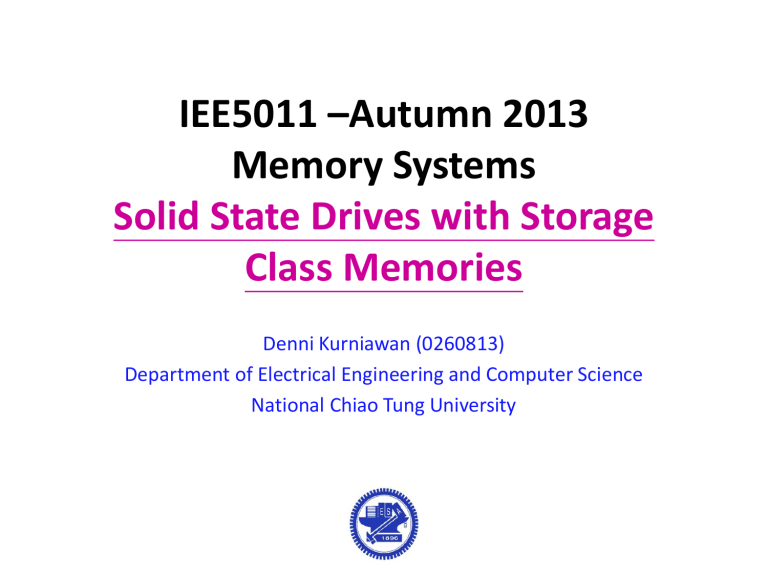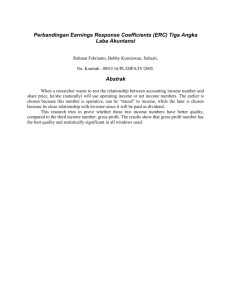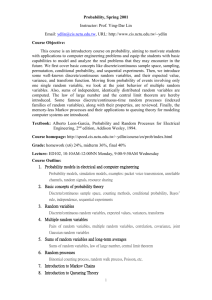Denni Kurniawan (260813)

IEE5011 –Autumn 2013
Memory Systems
Solid State Drives with Storage
Class Memories
Denni Kurniawan (0260813)
Department of Electrical Engineering and Computer Science
National Chiao Tung University
Outline
Introduction
Solid-State Drive
NAND Flash Memory
SSD Architecture
NAND Flash Trend
Storage Class Memory
Conclusion
Reference
NCTU IEE5011 Memory Systems 2013 Denni Kurniawan (260813) 2
Introduction
Denni Kurniawan (260813) NCTU IEE5011 Memory Systems 2013 3
Introduction
Denni Kurniawan (260813) NCTU IEE5011 Memory Systems 2013 4
Introduction
Denni Kurniawan (260813) NCTU IEE5011 Memory Systems 2013 5
Solid-State Drive
A Solid-state drive (SSD) is a storage device using to store data persistently.
SSD does not contain moving mechanical disk as in hard-disk drive (HDD).
Denni Kurniawan (260813) NCTU IEE5011 Memory Systems 2013 6
Solid-State Drive
SSD Advantages
No spin-up time
Fast, random-access to data
Use less power consumption
Far more robust
Silent
Denni Kurniawan (260813) NCTU IEE5011 Memory Systems 2013 7
Solid-State Drive
SSD Disadvantages
High storage cost per gigabyte
Lower drive capacities
Relatively low write speed
Denni Kurniawan (260813) NCTU IEE5011 Memory Systems 2013 8
NAND Flash Memory
Denni Kurniawan (260813) NCTU IEE5011 Memory Systems 2013
Source: Campordo et al. 2005
9
NAND Flash Memory
Read mode flash memory architecture
Denni Kurniawan (260813) NCTU IEE5011 Memory Systems 2013
Source: Campordo et al. 2005
10
NAND Flash Memory
Write mode flash memory architecture
Denni Kurniawan (260813) NCTU IEE5011 Memory Systems 2013
Source: Campordo et al. 2005
11
NAND Flash Memory
Erase mode flash memory architecture
Denni Kurniawan (260813) NCTU IEE5011 Memory Systems 2013
Source: Campordo et al. 2005
12
SSD Architecture
A memory controller task:
To provide the most suitable interface and protocol towards the host and flash memories.
To efficiently handle data, maximizing transfer speed, data integrity and information retention.
Denni Kurniawan (260813) NCTU IEE5011 Memory Systems 2013
Source: Takeuchi, 2009
13
SSD Architecture
FTL is used to map logical blocks to their locations within physical flash memory.
An FTL allows file systems and SSD to maintain the block interface of disks and control over how the flash is managed.
Two types of FTL a log-based approach and mapping consecutive ranges.
Wear leveling techniques rely on the concept of logical to physical translation.
Bad Block Management module creates and maintains a map of bad blocks.
Denni Kurniawan (260813) NCTU IEE5011 Memory Systems 2013
Source: Takeuchi, 2009
14
NAND Flash Trend
Denni Kurniawan (260813) NCTU IEE5011 Memory Systems 2013
Source: Wei Hwang, NCTU
15
NAND Flash Trend
Denni Kurniawan (260813) NCTU IEE5011 Memory Systems 2013
Source: Wei Hwang, NCTU
16
NAND Flash Trend
Denni Kurniawan (260813) NCTU IEE5011 Memory Systems 2013 17
NAND Flash Trend
Denni Kurniawan (260813)
IEEE International solid-state circuit conference
NCTU IEE5011 Memory Systems 2013 18
NAND Flash Trend
Denni Kurniawan (260813) NCTU IEE5011 Memory Systems 2013
Source: Wei Hwang, NCTU
19
NAND Flash Trend
Denni Kurniawan (260813) NCTU IEE5011 Memory Systems 2013
Source: Wei Hwang, NCTU
20
Storage Class Memory
Denni Kurniawan (260813) NCTU IEE5011 Memory Systems 2013
Source: Takeuchi, 2008
21
Storage Class Memory
Denni Kurniawan (260813) NCTU IEE5011 Memory Systems 2013
Source: Wei Hwang, NCTU
22
Storage Class Memory
Denni Kurniawan (260813) NCTU IEE5011 Memory Systems 2013
Source: IBM
23
Storage Class Memory
Denni Kurniawan (260813) NCTU IEE5011 Memory Systems 2013
Papers presented at
Symposium on VLSI Technology
IEDM (Int. Electron Devices Meeting)
24
Storage Class Memory
Memory capacity vs. cycle time
Denni Kurniawan (260813) NCTU IEE5011 Memory Systems 2013
Source: Everspin technologies
25
Storage Class Memory
Memory Endurance vs. cycle time
Denni Kurniawan (260813) NCTU IEE5011 Memory Systems 2013
Source: Everspin technologies
26
Storage Class Memory
Read vs. Write Bandwidth
Denni Kurniawan (260813) NCTU IEE5011 Memory Systems 2013
Source: Wei Hwang, NCTU
27
Conclusion
• SSD based NAND flash technology successfully replace
HDD as storage device.
• SCM is a new class that reduce boundaries between storage/memory technology.
• The features of SCM technologies should be: nonvolatile, short access times (~DRAM like), low cost per bit
(more DISK like), and solid state
• The goal of SCM development is to create compact, robust storage and memory systems with greatly improved cost/performance ratios relative to other technologies.
Denni Kurniawan (260813) NCTU IEE5011 Memory Systems 2013 28
Conclusion
There are many technologies that claim the best for SCM application such as PCRAM, RRAM, FeRAM, and MRAM, but all of them are still in the competition.
Denni Kurniawan (260813) NCTU IEE5011 Memory Systems 2013 29
References
1.
F. Masuoka et al., “New ultra high density EPROMand flash EEPROM with NAND structured cell,” in IEDM Tech. Dig., 1987, pp. 552–555.
2.
J. K. Kim et al., “A 120-mm 64-Mb NAND flash memory achieving 180 ns/byte effective program speed,” IEEE J. Solid-State
Circuits, vol.32, pp. 670–680, 1997.
3.
S. Aritome et al., “A reliable bi-polarity write/erase technology in flash EEPROMs,” in IEDM Tech. Dig., 1990, pp. 111–114.
4.
Fontana, R.E.; Decad, G.M.; Hetzler, S.R., "The impact of areal density and millions of square inches (MSI) of produced memory on petabyte shipments of TAPE, NAND flash, and HDD storage class memories," Mass Storage Systems and
Technologies (MSST), 2013 IEEE 29th Symposium on , vol., no., pp.1,8, 6-10 May 2013
5.
K. Takeuchi et al., “A56 nmCMOS 99mm 8 Gbit multi-level NAND flash memory with 10 Mbyte/sec program throughput,” in
IEEE ISSCC Dig., 2006, pp. 144–145.
6.
K. Kanda et al., “A 120 mm 16 Gb 4-MLC NAND flash memory with 43 nm CMOS technology,” in IEEE ISSCC Dig., 2008, pp.
430–431.
7.
K. Takeuchi, “NAND successful as a media for SSD,” presented at the IEEE ISSCC, Tutorial T7, 2008.
8.
K. Takeuchi., Novel co-design of NAND flash memory and NAN flash controller circuits for sub-30 nm low-power high-speed solid-state drives (SSD), Journal of solid-state circuits, vol. 44, no. 4, 2009.
9.
G.Goodson & R. Iyer, Design tradeoffs in a flash translation layer', 2010.
10. T. Tanzawa, T. Tanaka, K. Takekuchi, R. Shirota, S. Aritome, H. Watanabe, G. Hemink, K. Shimizu, S. Sato, Y. Takekuchi, K.
Ohuchi, A compact on-chip ECC for low cost Flash memories. IEEE J. Solid-State Circuits 32(May), 662–669 (May 1997)
11. G. Campardo, R. Micheloni et al., 40-mm2 3-V-only 50-MHz 64-Mb 2-b/cell CHE NOR Flash memory. IEEE J Solid-State
Circuits. 35(11), 1655–1667 (Nov 2000)
12. R. Micheloni et al., A 4Gb 2b/cell NAND flash memory with embedded 5b BCH ECC for 36 MB/s system read throughput, in
IEEE International Solid-State Circuits Conference Dig.Tech. Papers, Feb 2006, pp. 142–143
Denni Kurniawan (260813) NCTU IEE5011 Memory Systems 2013 30
References
13. R. Micheloni, A. Marelly, K. Eshghi, "Inside solid state drives (SSDs)", Springer series in advanced microelectronics 37,
Dordrecht. 2013.
14. L.M.Caulfield, "Symbiotic solid state drives: Management of modern NAND flash memory", Unpublished Doctoral's
Dissertation, University of California, United States.
15. R.F.Freitas. W.W. Wilcke. Storage-class memory: the next storage system technology". IBM Journal of R. and D., 52(4/5):439–
447, 2008.
16. J.G.Yun, Y. Kim, H. Shin. "Single-Crystalline Si Stacked Array (STAR) NAND Flash Memory." Electron Devices, IEEE Transactions on 58.4 (2011): 1006-1014.
17. B. Eitan, R. Kazerounian, A. Roy, G. Crisenza, P. Cappelletti, and A. Modelli, ‘‘Multilevel Flash Cells and Their Trade-offs,’’
International Electron Devices Meeting, IEDM Technical Digest, December 8–11, 1996, pp. 169–172.
18. K. Gopalakrishnan, R. S. Shenoy, C. T. Rettner, R. S. King, Y. Zhang, B. Kurdi, L. D. Bozano, et al., ‘‘The Micro to Nano
Addressing Block (MNAB),’’ IEEE International Electron Devices Meeting, IEDM Technical Digest, December 5–7, 2005, pp.
471–474.
19. S. Raoux, G. W. Burr, M. J. Breitwisch, C. T. Rettner, Y.-C. Chen, R. M. Shelby, M. Salinga, et al., ‘‘Phase-Change Random Access
Memory: A Scalable Technology,’’ IBM J. Res. & Dev. 52, No. 4/5, 465–479 (2008, this issue).
20. S. Hudgens and B. Johnson, ‘‘Overview of Phase-Change Chalcogenide Nonvolatile Memory Technology,’’ MRS Bull. 29, No.
11, 829–832 (2004).
21. B.C.Lee, ; P. Zhou; J. Yang; Y. Zhang; B. Zhao; E. Ipek.; O. Mutlu; D. Burger., "Phase-Change Technology and the Future of Main
Memory," Micro, IEEE , vol.30, no.1, pp.143,143, Jan.-Feb. 2010
22. L. C. Tran, ‘‘Challenges of DRAM and Flash Scaling Potentials in Advanced Emerging Memory Devices,’’ Proceedings of the
Seventh International Conference on Solid-State and Integrated Circuits Technology, October 18–24, 2004, pp. 668–672.
23. J. D. Aasheim and Y. Yang, ‘‘System and Method for Achieving Uniform Wear Levels in a Flash Memory Device,’’ European
Patent Application No. EP20030000541, 2003.
Denni Kurniawan (260813) NCTU IEE5011 Memory Systems 2013 31





